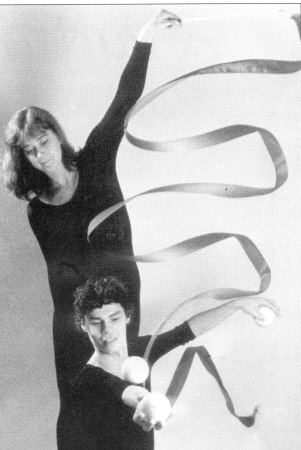
Kati Yla-Hokkala and Sean Gandini (Dave Pickens photo) |
Page 21 Winter 1993-94
|
The
clubs gravitated towards the
Yla-Hokkola,
the true sorceress of the piece, then entered dancing with a
ribbon to the winding tune of Shepard's clarinet. When Gandini
joined her with
In one of the livelier segments, balls were juggled along a diagonal to the percussive clapping of the musicians, creating a Brazilian effect and complementing the capeolera-like choreography. Just when the chaotic formations appeared to cross the line into random improvisation, order popped up as hands appeared at exactly the right moments for unassuming catches. Gandini confirmed the difficulty of maintaining such precise interactions. "In practice, if one person is one count off, it throws the counting off and there's no chance of ending it together," he said.
After
this festive interlude, the piece took a scientific turn as
Yla-Hokkola manipulated a water-filled club and Day passed an
increasing array of props around his head and shoulders in one of
those titillating moments which eludes description. Day brings an
interest in mathematics to the work and the troupe is clearly as
concerned with the scientific aspects of juggling as the artistic.
Gandini
brought the piece to a smashing conclusion by juggling five clay
balls and allowing them to shatter into smithereens on the floor.
In the full show, this action is accompanied by a reading of
Beckett text,
By
this time the jugglers have melded
After
the demonstration at Leeds, Gandini and YlaHokkola gave
workshops, and jugglers had a chance to verify that it is indeed
as difficult as it looks to learn these techniques. Their work
provided a refreshingly serious diversion at a gathering which
tends to gravitate toward hilarity, as was exemplified at the
midnight cabaret in a good-natured parody entitled "Yawn
Gandini Project."
.
This
indicated that, while the Gandinis' exploration of dance technique
has served them well in the physical sense, some of the elements
which make modern dance seem remote and inaccessible to many occur
in the Gandini presentation, though enlivened by the presence of
juggling.
While
some come away having experienced illusion rather than magic, it
must be kept in mind that whenever someone tries to make advances
in the field their work is criticized more harshly than even the
most generic routine. Once ideals are brought into the act,
controversy arises - much easier to leave them in the trunk and
perform a flashy presentation along with the rest.
In
challenging the usual concept of "stage presence," the
Gandinis are present in a different, perhaps deeper, way. The
Cindy
Marvell is a New York-based performer and former IJA
Seniors Champion now performing with Darn, Good and Funny in
Oklahoma. |

Kati Yla-Hokkala and Sean Gandini (Dave Pickens photo) |